Reading the so-called Sumerian Seals relating to Gods from outer space
In a recent article on Ancient Origins, Jason Jarrell and Sarah Farmer discussed the possibility that Zecharia Sitchin mistranslated several Sumerian Texts. According to Sitchin, there were a number of Sumerian seals that relate to the Anunnaki, whom he said came from the heavens to create man and enslave mankind to work in the mines. Although this is the opinion of Sitchin and his supporters, the Sumerian seals they cite as evidence for this enslavement relate to the simple worship of the gods by the Sumerians. These seals were actually talismans that were meant to encourage the Sumerian people to reflect on their gods and do good, no more.
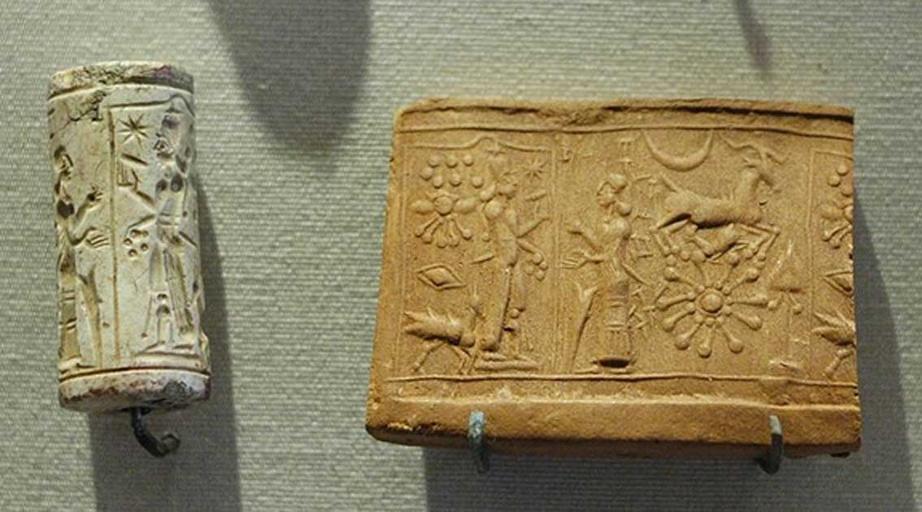
A careful translation of these seals indicate that they have nothing to do with space travel or the so-called Niburans. These seals relate to being good luck talismans, reminding the bearer of the seals to worship their gods—not space travel.
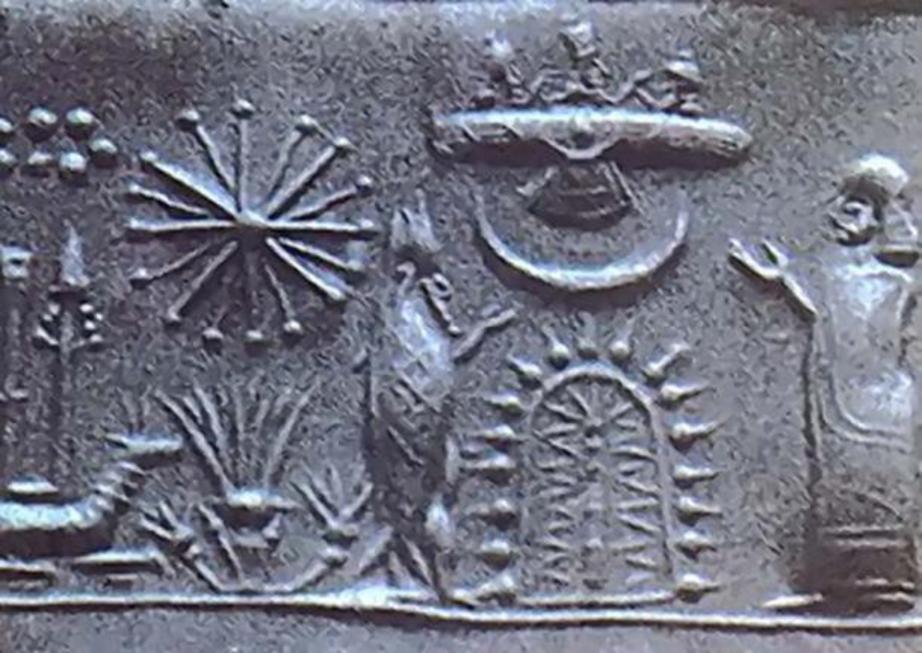
1st Millennium Mesopotamian/Sumerian cylinder seal. (Public Domain)
In the above figure, we see a number of Sumerian signs. There are three figures. These signs are associated with the figures.
In the image we see the Sumerian sign of kingship which is represented by the figure which is star-shaped and includes sixteen points. The dot reads li, and the line is i. In Sumerian li i means “to become visible/shine”.
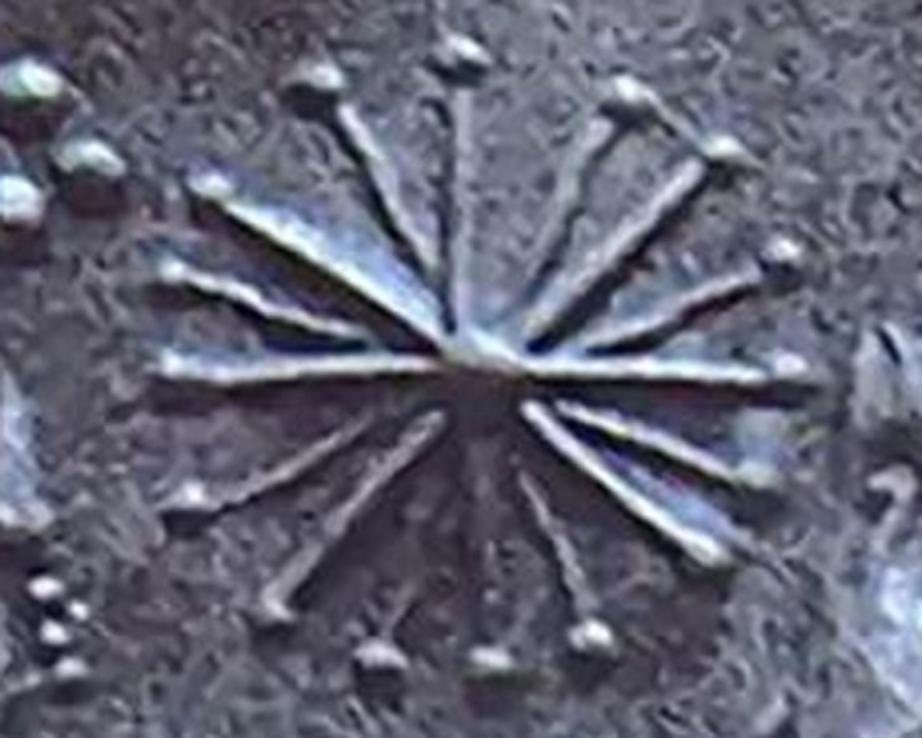
Sixteen point star. Detail, Sumerian cylinder seal. (Public Domain)
Next, we see two gods. On the left, we see a human-fish figure. This god may represent the god Ea who was like a fish and is supposed to be the creator of man. The other god may be Enlil. The hands of the gods pointing to the log represent the signs, i ta, and reads “Send forth his Touch”.
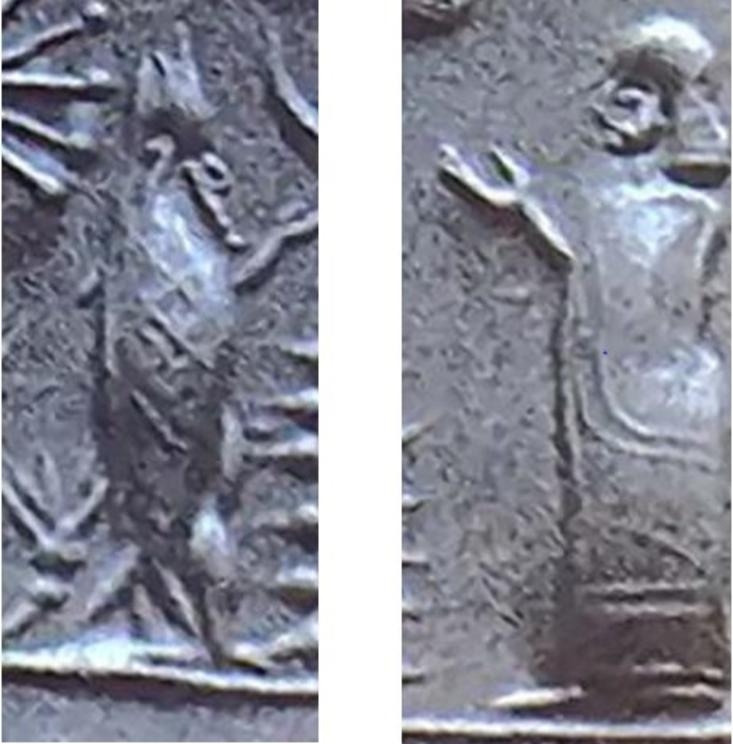
Likely god Ea. Possible god Enlil.
Between the gods and above them, we see a log-shaped figure with a number of lines. On the right-hand side of the log we see two signs: a hook with a line under it. The hook is probably the u sign, the line is read i. The two signs would read u i, “Witness amazement”.
In the Center of the log we see a dot (li), a half circle (a) under the dot and a fan like symbol (pa). Under the fan is a large half circle (a). These symbols read Li a pa A, or “Become visible a strong leader. The Father”.
At the end of the log on the left-hand side we see three signs: a vertical line (i), with two horizontal lines (gu) between it and another vertical line. These signs read i gu i or “Become a visible witness to benefit man”.
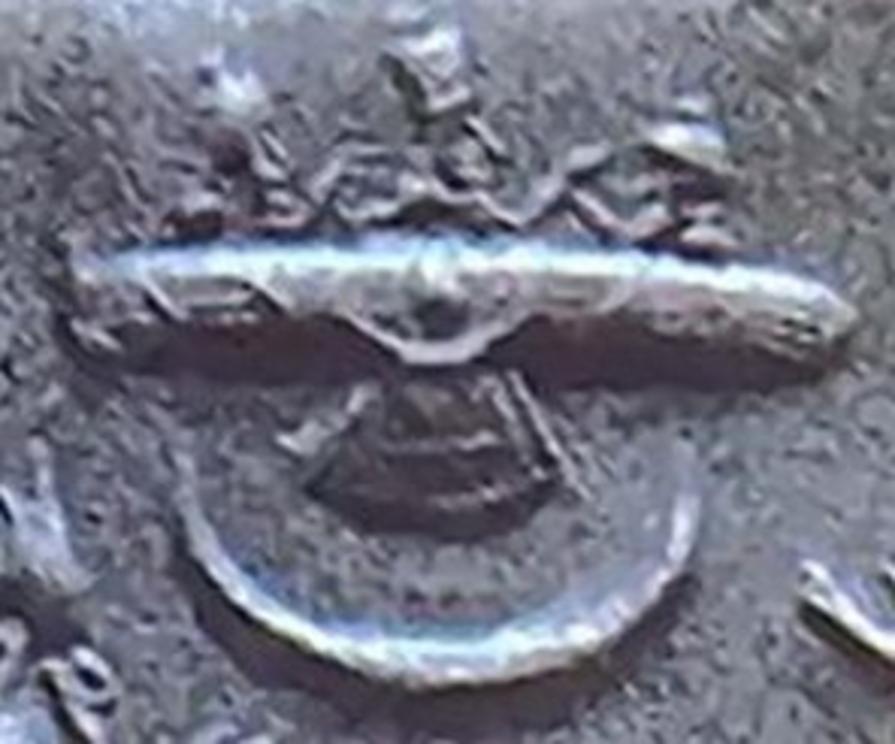
Log-shaped figure.
Under the a sign, in the center of the seal we see a figure surrounded by the dot line symbol = li i ‘Become visible”. The next sign is the u, “Powerful/Nourish”. Within the u sign we see repeatedly the dot (li) sign between two lines on either side (gu). Li gu = “send forth sustenance”. These symbols probably read “Become visible a powerful (Leader/Father) to send forth sustenance for mankind”.
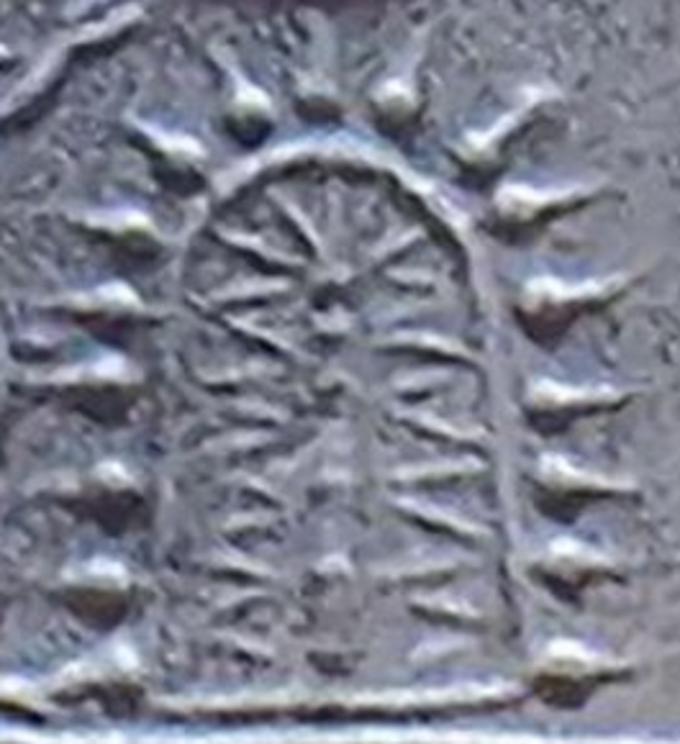
Figure surrounded by the dot line symbol.
The Enlil situated at the end of the seal has his hand made in the shape of the tu sign, and reads, i tu, “Send forth the libation”. The god Ea’s hand is shaped in sign of i ta, and reads Send forth (his/the) Touch”.
Let’s read the seal from right to left. Signs to the far right of the seal read:
Me mi mi I i-ta mi ge i u u mi gu lu a a i-me
Or:
“The diviner has much power from the deity to send forth[blessings]. Send forth the character of the Diviner. Act to send forth amazement to nourish the oracle and sustain man. The strong Father sends forth the oracle”.
Next, we see a figure that resembles an arrow or spear seated on a base. This spear or arrow figure is made up of a number of signs. They read Pa ta u “Reveal the character of a powerful man”.
On the left side of the spear/arrow figure we see a number of signs beginning with a wave (zi) sign slightly above the head of the god. The wavy sign is zi and reads righteousness or ‘breath of life’.
The god’s hand points at the top of the spear. The other hand is changed in the i ta signs=Send forth (his/ the) touch”. Below this hand we see two columns of signs. There are three signs to the right Su a-i u and reads “Wisdom sprouts from the Father/Leader and amazement”.
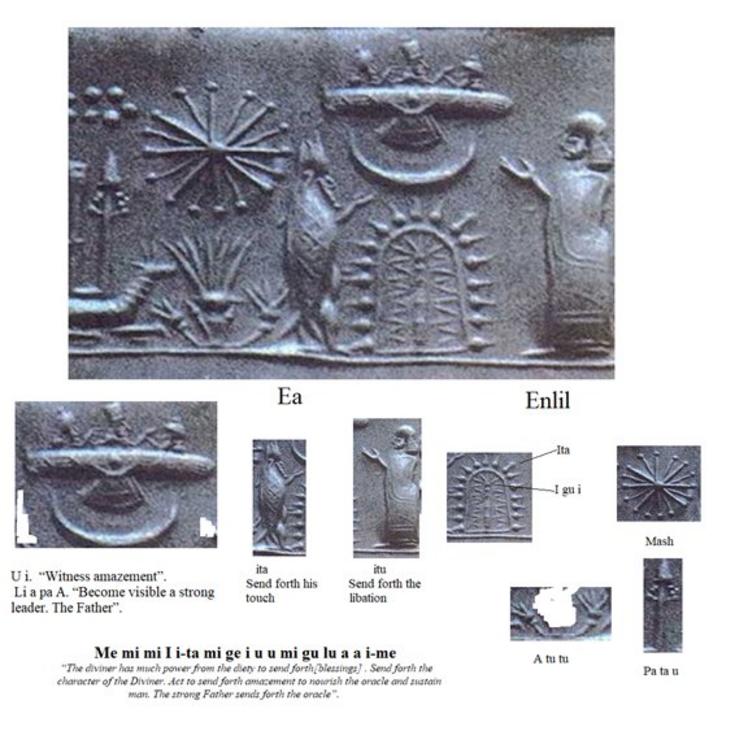
There are five signs on the left side under the hand. They read: Mi mi ta be ta, or:
“The phenomenal oracle to open up speech and entrust benefit (for MAN/YOU)”.
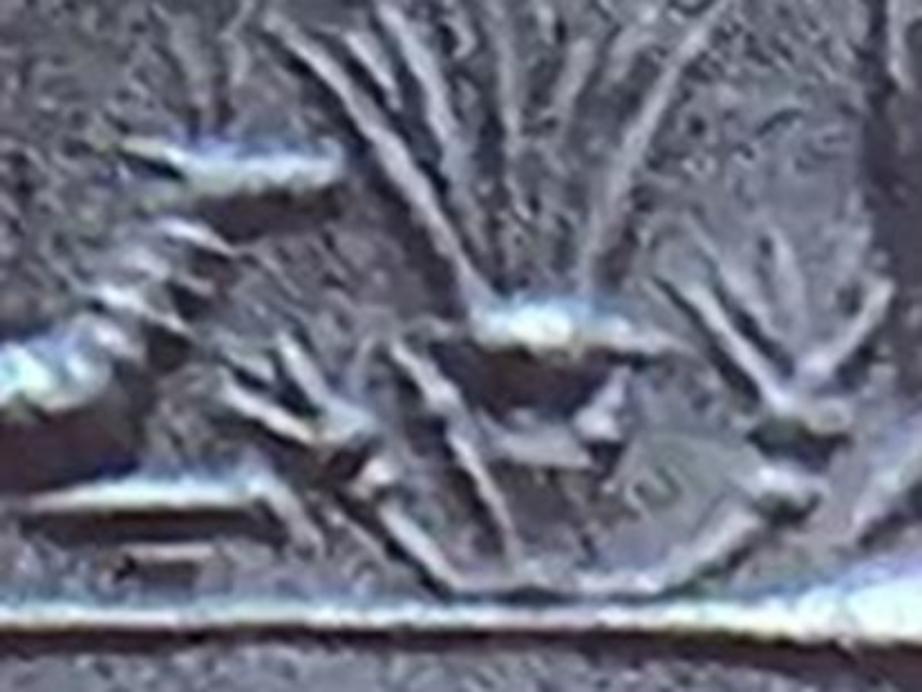
God hand on the left with signs to the right.
Above the wavy line, we see a figure that has a u symbol, above a circle between two boxes or logs, with a fan under the circular figure. The u symbol equals u, the box figures read bu mesh, the circle sign = ta and the fan below the circle is pa. This figure reads U bu mesh ta bu mesh pa, “The Powerful man supports the character of a super perfect Diviner and leader”.
It is important to note that when a sign is doubled, this represents reduplication or plural nature of the signs.
There are Proto-Sumerian signs behind the middle god, between the god at the far left of the seal. The First sign is a half-moon which reads u or “Gaze (at)”. The rest of the signs, reading from top to bottom are lu mi ta mi ta gun a lu mi mi i be. Tu mi i. This passage reads:
“Gaze (at) the man of power. Open up the divine decree. Entrust benefit to human beings. Distribute the oracle’s divine decree to witness speech. Go forth to make a libation (at the) oracle.”
This seal is also relating to offering libation to the gods at an oracle. This oracle appears to speak to the supplicants.
Given the text on the seal, the figure on the log probably represents Anu, the sky Creator of all gods.
These seals are telling man(kind) to offer a libation to Anu, to make this god a visible figure in their life.
A Sumerian Reading of the ‘12th Planet’ Seal
Proto-Sumerian seal 4, is a very interesting Sumerian cylinder seal titled VA 243. This is a famous seal because Ancient Alien theorists believe that VA 243 describes the Annunaki migration to earth. Michael S. Heiser, in “The Myth of the 12th Planet: A Brief Analysis of Cylinder Seal VA 243”, argues that this seal does not support the theory of a 12th Planet popularized by Zecharia Sitchen.
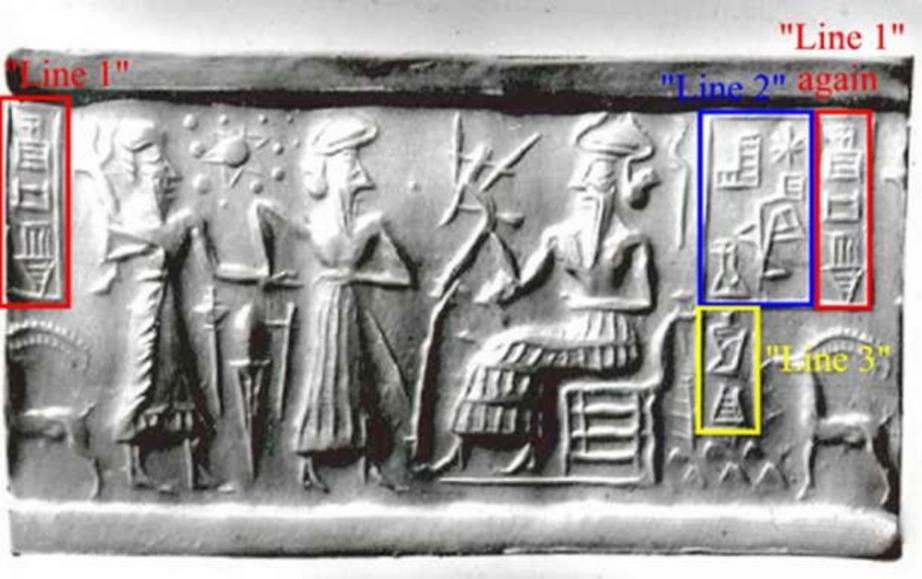
Cylinder Seal VA 243 was first translated in 1940, by Anton Moortgat. Moortgat published his translation in the Berlin Vorderasiatische Museum’s publication of its seal collection, Vorderasiatische Rollsiegel (“West Asian Cylinder Seals”) by Mesopotamian scholar Anton Moortgat. Dr. Heiser provides an English translation of the German text as follows:
Line 1 = dub-si-ga “Dubsiga” [a personal name of an apparently powerful person]
Line 2 = ili-il-la-at “Ili-illat” [another personal name, this time of the seal’s owner]
Line 3 = ir3-su “dein Knecht” [German for “your servant”]
In summary Moortgat’s translation of inscription of VA243 reads: “Dubsiga, Ili-illat, your/his servant.”
Although this is Dr. Moortgat’s translation of Cylinder Seal VA243, my reading of VA243 is much different. I interpret VA243 by reading the signs as Linear Sumerian, instead of cuneiform.
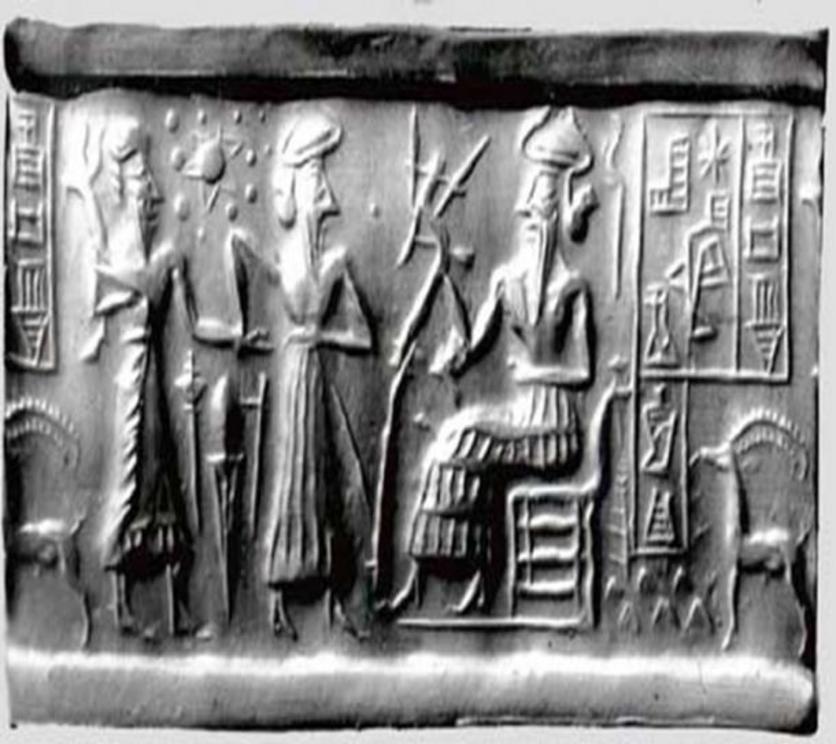
Proto-Sumerian Seals 4
An examination of V243 indicates that this Cylinder Seal was a talisman. In addition to the three boxes of text discussed by Dr. Moortgat, there are also iconographic elements in the Cylinder Seal that also represent Linear Sumerian signs as illustrated in the Proto-Sumerian 4 Figure.
In this translation of Cylinder Seal VA243, I will not decipher and read the star and dot signs. The seal reads as follows:
“The Divinity has the power to raise up the talisman’s divine decree [for] this man. The depth of the talisman is to perfect the Diviner. God perfect this man’s divine decrees. This talisman commands [it]. Make perfect the libations. Make libations to the oracle Pure Esteem that goes to Heaven”
To summarize, these seals relate to being good luck talismans reminding the bearer of the seals to worship their gods—not space travel.
This discussion of Proto-Sumerian seal writing systems makes it clear that various ancient people in Sumer used a linear syllabic script. The seal inscriptions the Sumerians left appear to have served as talismans or amulets. The seals were carved to illustrate the devotion of the Sumerians to their gods and goddesses and are a great testimony to the great civilizations built by the people of Sumer.

Cult scene: the worship of the sun-god, Shamash. Limestone cylinder-seal, Mesopotamia. (Public Domain)
For the rest of this article please go to source link below.
For full references please use source link below.
